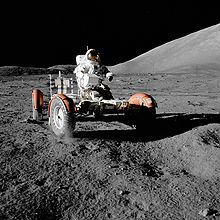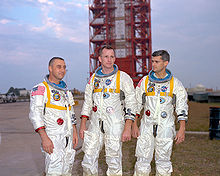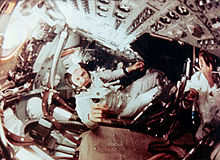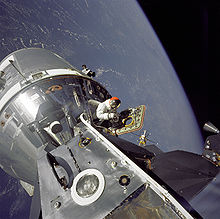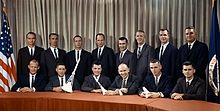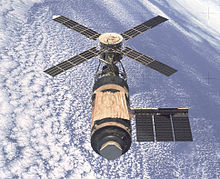- List of Apollo astronauts
-
Forty-one astronauts were assigned to fly Apollo spacecraft; thirty-two of them were part of the Apollo program, with the rest not flying until the subsequent Skylab and Apollo-Soyuz programs. Twenty-four of the Apollo program astronauts left Earth’s orbit and flew around the Moon (Apollo 7 and Apollo 9 did not leave low Earth orbit).
Twelve of these astronauts walked on the Moon’s surface, and six of those drove a lunar rover on the Moon. While three astronauts flew to the Moon twice, none of them landed on the Moon more than once. The nine Apollo missions to the moon occurred between December of 1968 and December of 1972.
Apart from these twenty-four people who visited the Moon, no human being has gone beyond low Earth orbit. They have, therefore, been farther from the Earth than anyone else. They are also the only people to have directly viewed the far side of the Moon. The twelve who walked on the Moon are the only people ever to have set foot on an astronomical object other than the Earth.
Of the twenty-four lunar astronauts taking part in the Moon missions, two went on to command a Skylab mission, one commanded Apollo-Soyuz, one flew as commander for shuttle approach and landing tests and two went on to command orbital shuttle missions. A total of twenty-four Apollo-era astronauts (as well as pre-Apollo astronaut John Glenn) flew the space shuttle.
Contents
Project Apollo fatalities
Although there were no in-flight fatalities in the Apollo program, three astronauts died in a ground test accident in what was later called Apollo 1.
- Virgil "Gus" Grissom – according to Deke Slayton, who assigned crews to flights during most of Apollo, Grissom would have been his choice to be the first to walk on the Moon.[1][2]
- Edward White.
- Roger B. Chaffee.
Other fatalities of Apollo astronauts
- Edward Givens – car accident near Houston, Texas, on June 6, 1967; was on support crew of Apollo 7.
- Clifton Williams – plane crash near Tallahassee, Florida, on October 5, 1967; was chosen as backup lunar module pilot for Apollo 9.
Apollo astronauts who walked on the Moon
Twelve people have walked on the Moon. All human landings took place between July of 1969 and December of 1972 as part of the Apollo program.
Name Born Died Age at
first stepMission Lunar EVA dates Employer 01. Neil Armstrong August 5, 1930 38y 11m 15d Apollo 11 July 21, 1969[3] NASA[4] 02. Buzz Aldrin January 20, 1930 39y 6m 0d Air Force 03. Pete Conrad June 2, 1930 July 8, 1999 39y 5m 17d Apollo 12 November 19–20, 1969 Navy 04. Alan Bean March 15, 1932 37y 8m 4d Navy 05. Alan Shepard November 18, 1923 July 21, 1998 47y 2m 18d Apollo 14 February 5–6, 1971 Navy 06. Edgar Mitchell September 17, 1930 40y 4m 19d Navy 07. David Scott June 6, 1932 39y 1m 25d Apollo 15 July 31 – August 2, 1971 Air Force 08. James Irwin March 17, 1930 August 8, 1991 41y 4m 14d Air Force 09. John W. Young September 24, 1930 41y 6m 28d Apollo 16 April 21–23, 1972 Navy 10. Charles Duke October 3, 1935 36y 6m 18d Air Force 11. Eugene Cernan March 14, 1934 38y 9m 7d Apollo 17 December 11–14, 1972 Navy 12. Harrison Schmitt July 3, 1935 37y 5m 8d NASA Regarding "the last man to walk on the Moon", Schmitt is the last person to arrive (as Cernan got out of the Apollo Lunar Module first), but Cernan is the last person to leave (after final EVA, Schmitt went inside the module first). Duke was the youngest, at age 36 (+6mo); Shepard was the oldest, at age 47 (+2mo).
James A. Lovell, John W. Young and Eugene Cernan are the only three astronauts to fly more than one lunar mission (two each). Of these three, only Lovell did not walk on the lunar surface. Lovell and Fred Haise were prevented from walking on the Moon by the malfunction on Apollo 13 that resulted in the mission being aborted. Haise was scheduled to walk on the Moon as commander of Apollo 19 prior to that mission’s cancellation on September 2, 1970.
Joe Engle had also trained to explore the Moon with Cernan as the backup crew for Apollo 14, but Engle was later replaced by geologist Harrison Schmitt when the primary crew for Apollo 17 was selected. Schmitt had been crewed with Dick Gordon in anticipation for Apollo 18. When Apollo 18 was canceled, Schmitt bumped Engle, leaving Gordon as the last Apollo astronaut who had trained extensively for lunar exploration without ever getting a chance to fly a lunar landing.
Apollo astronauts who flew to the Moon without landing
Twelve more people have been within a few hundred kilometers of the Moon. On each of the missions listed above one astronaut orbited the Moon while the other two landed. In addition, the Apollo 8, Apollo 10, and Apollo 13 missions had a three-person crew and closely encountered the Moon, entering orbit in the case of the former two missions, while Apollo 13 only passed around it. John Young and Eugene Cernan both flew to the Moon twice, each setting foot on it as part of their second journey, while Jim Lovell is the only human to have flown to the Moon twice without landing on it.
Name Born Died Age on mission Mission Mission dates Employer Other notes 1. Frank Borman March 14, 1928 40 Apollo 8 December 21–27, 1968 Air Force 2. Jim Lovell March 25, 1928 40 Apollo 8 December 21–27, 1968 Navy 42 Apollo 13 April 11–17, 1970 intended to land 3. William Anders October 17, 1933 35 Apollo 8 December 21–27, 1968 Air Force 4. Tom Stafford September 17, 1930 38 Apollo 10 May 18–26, 1969 Air Force 5. John Young September 24, 1930 38 Apollo 10 May 18–26, 1969 Navy later landed on Apollo 16, commanded two space shuttle missions 6. Eugene Cernan March 14, 1934 35 Apollo 10 May 18–26, 1969 Navy later landed on Apollo 17 7. Michael Collins October 31, 1930 38 Apollo 11 July 16–24, 1969 Air Force 8. Dick Gordon October 5, 1929 40 Apollo 12 November 14–24, 1969 Navy had been slated to land on Apollo 18[5] 9. Jack Swigert August 30, 1931 December 27, 1982 38 Apollo 13 April 11–17, 1970 Air Force 10. Fred Haise November 14, 1933 36 Apollo 13 April 11–17, 1970 Air Force intended to land; had been slated to land on Apollo 19,[5] flew shuttle for approach/land testing 11. Stuart Roosa August 16, 1933 December 12, 1994 37 Apollo 14 January 31 – February 9, 1971 Air Force had been slated to land on Apollo 20 12. Al Worden February 7, 1932 39 Apollo 15 July 26 – August 7, 1971 Air Force 13. Ken Mattingly March 17, 1936 36 Apollo 16 April 16–27, 1972 Navy commanded two space shuttle missions. Originally in crew of Apollo 13, but replaced after becoming exposed to German measles pre-flight 14. Ronald Evans November 10, 1933 April 7, 1990 39 Apollo 17 December 7–19, 1972 Navy Other Apollo astronauts
Apollo 7 and Apollo 9 orbited the Earth only; therefore these five Apollo astronauts never went to the Moon:
- Walter Schirra – Apollo 7
- Donn Eisele – Apollo 7 (was on backup-crew for Apollo 10)
- Walter Cunningham – Apollo 7
- James McDivitt – Apollo 9
- Rusty Schweickart – Apollo 9 (was on backup-crew for Skylab 2)
David Scott from Apollo 9 went on to land on the Moon in Apollo 15.
Backup crew-members who never flew an Apollo flight
Each Apollo flight had a backup crew who trained to carry out the mission if the prime crew member was unable to fly. Only one backup crew member was ever used: Jack Swigert switched places with Ken Mattingly after Mattingly had been exposed to German measles a few days prior to the launch of Apollo 13. (Mattingly later flew aboard Apollo 16). However, shortly before the launch of Apollo 17, Eugene Cernan badly injured his leg playing softball and only just recovered in time for the mission. Had he been unable to fly he could have been replaced by back-up commander John Young, who would have become the only person to walk on the Moon twice and would have done so on consecutive missions.
- Gordon Cooper – backup commander for Apollo 10 – lost the primary commander slot on Apollo 14 to Alan Shepard, and resigned from NASA in 1970.
- Joe Henry Engle – backup lunar module pilot for Apollo 14 – lost the primary pilot slot on Apollo 17 to Harrison Schmitt after the cancellation of Apollo 18. Engle later flew on the Space Shuttle Enterprise during the Approach and Landing Tests program in 1977, and commanded STS-2 using Columbia with astronaut Richard Truly in 1981. He also commanded Discovery on STS-51-I in 1985.
Astronauts who flew on Apollo, listed by group
- From the Mercury Seven (Astronaut Group 1)
Group 1 astronauts flew on Apollo 7 and 14
- From Astronaut Group 2
Group 2 astronauts flew on Apollo 8, 9, 10, 11, 12, 13, and 16; and ASTP and Skylab 2
- Neil Alden Armstrong – Apollo 11
- Frank Frederick Borman II – Apollo 8
- Charles "Pete" Conrad, Jr. – Apollo 12, Skylab 2
- James Arthur Lovell, Jr. – Apollo 8, Apollo 13
- James Alton McDivitt – Apollo 9
- Thomas Patten Stafford – Apollo 10, Apollo-Soyuz Test Project
- John Watts Young – Apollo 10, Apollo 16 (Also flew on STS-1 and STS-9)
- From Astronaut Group 3
Group 3 astronauts flew on Apollo 7, 8, 9, 10, 11, 12, 15, and 17; and Skylab 3
- Buzz Aldrin – Apollo 11
- William Alison Anders – Apollo 8
- Alan LaVern Bean – Apollo 12, Skylab 3
- Eugene Andrew Cernan – Apollo 10, Apollo 17
- Michael Collins – Apollo 11
- Walter Cunningham – Apollo 7
- Donn Fulton Eisele – Apollo 7
- Richard Francis Gordon, Jr. – Apollo 12
- Russell Louis "Rusty" Schweickart – Apollo 9
- David Randolph Scott – Apollo 9, Apollo 15
- From Astronaut Group 4
Group 4 astronauts flew on Apollo 17
- From Astronaut Group 5
Group 5 astronauts flew on Apollo 13, 14, 15, 16, and 17
- Charles Moss Duke, Jr. – Apollo 16
- Ronald Ellwin Evans, Jr. – Apollo 17
- Fred Wallace Haise, Jr. – Apollo 13
- James Benson Irwin – Apollo 15
- Thomas Kenneth Mattingly II – Apollo 16
- Edgar Dean Mitchell – Apollo 14
- Stuart Allen Roosa – Apollo 14
- John Leonard "Jack" Swigert, Jr. – Apollo 13
- Alfred Merrill Worden – Apollo 15
Post-Apollo missions using Apollo hardware
The following astronauts flew on post-Apollo missions using Apollo hardware:
From the Mercury Seven
From Astronaut Group 2
- Charles "Pete" Conrad, Jr. – Skylab 2 (Also flew on Apollo 12, Gemini 5. and Gemini 11)
- Thomas Patten Stafford – Apollo-Soyuz Test Project (Also flew on Apollo 10, Gemini 6, and Gemini 9)
From Astronaut Group 3
- Alan LaVern Bean – Skylab 3 (Also flew on Apollo 12)
From Astronaut Group 4
- Owen Kay Garriott – Skylab 3 (Also flew on STS-9)
- Edward George Gibson – Skylab 4
- Joseph Peter Kerwin – Skylab 2
From Astronaut Group 5
- Vance DeVoe Brand – Skylab Rescue (never flown), Apollo-Soyuz Test Project (Also flew on STS-5, STS-41-B, and STS-35)
- Gerald Paul Carr (had been slated to land by Apollo 19) – Skylab 4
- Jack Robert Lousma (had been slated to land by Apollo 20) – Skylab 3 (Also flew on STS-3)
- William Reid Pogue – Skylab 4
- Paul Joseph Weitz – Skylab 2 (Also flew on STS-6)
References
- ^ Zornio, Mary C. Detailed Biographies of Apollo I Crew - "Gus Grissom", NASA, accessed July 19, 2006.
- ^ Slayton, Donald K; Cassutt, Michael (1994). Deke!: U.S. Manned Space from Mercury to the Shuttle (1st ed.). New York City: Forge: St. Martin's Press. ISBN 0312855036. OCLC 29845663.
- ^ This date is based on GMT. Americans alive at the time remember it as the night of July 20, 1969 (Armstrong set foot on the Moon at 10:56 p.m. Eastern Daylight Time), but the official NASA chronology was kept in GMT, so the first step was 2:56 a.m. on the 21st: [1]
- ^ Armstrong had left the US Navy and was already a NASA employee when he and Elliot See became the first civilian astronauts in Astronaut Group 2. See Armstrong's NASA biography and a description of his receiving a NASA award, among others.
- ^ a b "Apollo 18 through 20 - The Cancelled Missions", Dr. David R. Williams, NASA, accessed July 19, 2006.
- "Human Space Flight - Apollo History". NASA. January 30, 2004. http://spaceflight.nasa.gov/history/apollo/. Retrieved 2007-01-08.
- One Giant Leap for Mankind: 35th Anniversary of Apollo 11, NASA, Michael Makara, accessed July 14, 2006
Spaceflight lists and timelines General - All spaceflights
- (records)
- Rocket and missile technology
- Space exploration
- (milestones 1957–1969)
Human spaceflight General- Manned spacecraft
- (timeline)
- Spaceflights
- (1961–1970
- 1971–1980
- 1981–1990
- 1991–2000
- 2001–2010
- 2011–present
- by program)
- Soviet
- Russian
- Mercury
- Gemini
- Apollo
- Shenzhou
- Expeditions
- Spaceflights (manned
- unmanned)
- Spacewalks · Visitors
- Expeditions
- Spaceflights (manned
- unmanned)
- Spacewalks · Visitors
- Astronauts (Apollo
- by name
- by year of selection)
- Cosmonauts
- Married couples among space travelers
- Space travelers by name
- Space travelers by nationality
- (timeline)
- Spacewalks and moonwalks (1965–1999
- 2000–present)
- Cumulative spacewalk records
- Spacewalkers
Solar System exploration Earth-orbiting satellites - Climate research
- Communications satellite firsts
- CubeSats
- Earth observation satellites
- (timeline)
- Geosynchronous orbit
- GOES
- Kosmos
- Magnetospheric
- NRO
- TDRS
- USA
Vehicles - Orbital launch systems
- (comparison of small lift launch systems
- comparison of medium lift launch systems
- comparison of orbital launch systems)
- Sounding rockets
- Spacecraft (unmanned
- manned)
- Upper stages
Launches by rocket type - Ariane
- Atlas
- Black Brant
- Long March
- Proton
- R-7
- Thor and Delta
- Titan
- V-2 tests
Agencies, companies
and facilitiesOther mission lists
and timelinesCategories:- Apollo program
- Lists of astronauts
- Lists of American people
Wikimedia Foundation. 2010.

